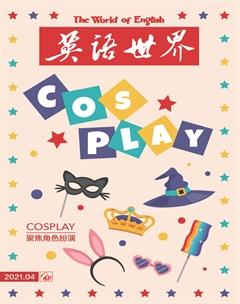The Origin Stories of 10 Cool Cosplay Terms角色扮演十大术语的由来
安杰拉·董 李宜芸
Cosplay and convention culture can trace their roots back to at least the 1970s, when in the U.S. fans began to appear at science fiction conventions dressed as Starfleet commanders, Luke Skywalker, and the like, and in Japan, college students attended manga and anime festivals donned in full character regalia.
Such a colorful culture has also given rise to colorful terminology. You can find 10 right here to introduce you to the world of cosplay.
1. Manga
The manga style of comics emerged from post-World War II Japan with Ozama Tezukas1 Astro Boy. The genre is drawn in a “meticulously detailed style,” according to the Oxford English Dictionary (OED), and is often associated with a science fiction or fantasy theme.
While the term first appeared in English in 1951, manga in Japanese is from 1799 or earlier. Translated as “involuntary pictures,” manga was coined in 1812 by artist Katsushika Hokusai2 to describe a free-flowing, quirky style.
2. Anime
While Japanese animation has existed since as far back as 1917, anime as we know it today arose in the 1970s. This term for whats basically the animated version of manga first appeared in English in 1985 and might be based on the French animé, animated or lively. Before the 1970s, Japanese animation was known as manga eiga3, or “TV manga.”
3. Cosplay
Cosplay, a blend of costume and play, comes from the Japanese kosupure, itself a Japanification of costume play, which originated in 19th-century English to refer to a costume drama.
Kosupure was coined by Nobuyuki Takahashi, who would later become a film editor on such J-horror classics as Ringu and Ju-On: The Grudge. But back in 1983, he was writing about fans who attended conventions dressed as their favorite manga and anime characters. The term kasou, a Japanification of costume, already existed, but didnt capture the right spirit of cosplay, according to Kotaku, while a translation of the English masquerade seemed too old-fashioned to Takahashi. Hence, kosupure was born.
4. Layer
Layer is Japanese slang for cosplayer. Layer Support is a cleaning service specifically for cosplay costumes.
5. Furry
A Furry is a fan of human-like animal characters and people dressed as such characters. While the OEDs earliest citation is from 1989, the Furry phenomenon probably began in the early 1980s, if not sooner.
6. Otaku
A Japanese loan word, otaku refers to someone extremely knowledgeable about a hobby or subculture, and who might be, at least according to the OED, skilled in “computer technology” and unskilled in interpersonal interaction. In other words, a nerd.
Otaku seems to have suffered a sort of reverse-reappropriation, at least in Japan. While in English, geek and nerd are traditionally pejorative terms that have gained a degree of coolness, otaku began in the early 1980s as an “insider” term—a way that anime and manga fans addressed each other, then any member of the subculture. Otaku only became an insult in the hands of the media commenting on such a subculture. Meanwhile, outside Japan, otaku has positive connotations, denoting someone whos an expert or aficionado.
Otaku translates literally from the Japanese as “your house” (in other words, people who are otaku dont leave the house), and cosplay otaku is thought of as a subset.
7. Chibi4
Chibi, which translates from Japanese as “runt,” is a cute kid version of an anime character. Chibi and super-deformed5 are sometimes used interchangeably. However, while all chibis are super-deformed, not all super-deformed are chibis. Chibis are always child-like, but super-deformed describes a character drawn in any exaggerated or deformed way.
Both are used in anime as parody or slapstick. For instance, a character may suddenly become chibi when behaving immaturely.
8. Post-con depression (PCD)
Returning to the humdrum of everyday life from a place where one might be treated like a rock star can be a huge downer. Hence, post-con depression, or PCD, the blues some cosplayers feel after attending a convention.
9. Con-plague
Post-convention, you might also endure the con-plague, sometimes called the con crud, an illness one catches after several days of being in close quarters with throngs of people, not eating well, and not getting enough sleep.
Theres much advice about how to avoid the con-plague, which are basically the same tactics to avoid catching a cold or the flu.
10. Glomping
If you dont want con-plague, you might also want to eschew glomping. An aggressive tackle-hug, glomp began as an anime term but has extended to convention use. Convention etiquette seems to be against it due to the possibility of costume crushing and bodily harm. Its unclear if glomping is innate behavior among enthusiasts or if its in imitation of anime characters.
According to TV Tropes6, glomp may come from the English translation of the sound effect of the overenthusiastic embrace in some manga. A popular theory says that glomp is a backronym of “Grab, Latch On, Maintain Pressure,” but more likely the word is imitative, and might be influenced by the English glom, to snatch or grab, or glamp, to grope or snatch at. ■
角色扮演及漫展文化至少可追溯到1970年代,当时美国的粉丝开始装扮成星际舰队指挥官、卢克·天行者之类的角色在科幻小说漫展上亮相,与此同时,日本的大学生们身着全副角色盛装,出席动漫节活动。
如此精彩纷呈的文化也催生出丰富有趣的词汇。下文十个术语将带你走进角色扮演的世界。
1. 漫画
第二次世界大战后,手冢治虫发表《铁臂阿童木》,日式漫画随之兴起。根据《牛津英语词典》(OED)的解释,这种体裁展现了“精细入微的风格”,且通常与科幻小说或玄幻主题相关。
虽然该词于1951年首次出现在英语中,但其日语词则始于1799年或更早。该词于1812年由画家葛饰北斋创造,其英译意为“笔法随意的画作”,用以描述一种自由奔放、古怪离奇的风格。
2. 动漫
尽管日本动画早在1917年就已存在,但我们今天所了解的“动漫”出现在1970年代。该词主要指日式漫画的动画版本,在英语中首次出现于1985年,可能来自法语animé一词,表示“生动的”“活泼的”。1970年代之前,日本动画被称为漫画电影,或“电视漫画”。
3. 角色扮演
cosplay由costume(服装)和play(扮演)组合而成,来自日语コスプレ。cosplay是costume play一词的日本化,该词源于19世纪英语,表示古装戏剧。
コスプレ一词由高桥伸之创造,他后来成为一名电影剪辑师,剪辑过日本经典恐怖影片《午夜凶铃》和《咒怨》。但1983年,他在写粉丝们打扮成自己最喜欢的漫画人物和动漫角色参加漫展。据Kotaku网站解释,kasou(日语写作“仮装”,意为“化装”)一词作为costume的对应日语词汇已经存在,但并没有体现角色扮演的精髓之处;在高桥伸之看来,根据英文masquerade(化装舞会)翻译太老气。因此,コスプレ一词应时而生。
4. 角色扮演者
layer是日语俚语,表示角色扮演者。“角色扮演者后援”是指专门为角色扮演服装提供清洁服务的组织。
5. 兽迷
兽迷喜欢拟人化动物角色,也喜欢那些扮演成这种角色的人。虽然OED在1989年首次援引该词,但“兽迷”现象可能始于1980年代初,甚至更早。
6. 御宅族
otaku(御宅族)借自日语,指非常了解某项嗜好或某种亚文化的人,起码在OED中是这样描述的:御宅族可能精通“计算机技术”,不擅长人际交往。换句话说,就是“书呆子”。
至少在日本,御宅族的语义似乎经历了某种逆向挪用。英语中的geek(怪人)和nerd(书呆子)通常带有贬义,在一定程度上有了“酷”的味道,而御宅族是1980年代初“圈内人士”开始使用的词语——动漫和漫画迷以此相互称呼对方,而后指称每个喜欢这一亚文化的人。由于媒体对这种亚文化品头论足,御宅族才开始带有贬损意味。但与此同时,在日本以外的地区,御宅族含有褒义,指某行业的高手或发烧友。
御宅族的日语按字面译后的意思是“您的房子”(换句话说,御宅族是指不出门的人),而喜欢角色扮演的御宅族属于其中一类。
7. 小小版
“小小版”从日语翻译过来意为“小不点儿”,指一个可爱的幼童化动漫人物。小小版和超变形有时互换使用。然而,虽然所有的小小版都是超变形的,但并不是所有超变形的都是小小版。小小版通常指像孩子的人物,而超变形是指用夸張或变形的方式描绘出的人物。
两者在动漫中都用来表现夸张或滑稽场景。例如,当角色的行为表现很幼稚时,可能会突然变成小小版形象。
8. 漫展后抑郁症
在漫展上可能被追捧为摇滚明星,再回到单调乏味的日常生活会让人异常失落。于是出现“漫展后抑郁症”,即PCD,指一些角色扮演者参加漫展后的失落情绪。
9. 漫展后遗症
漫展结束后,你也可能患上漫展后遗症,有时被称为“漫展怪病”。参与者在多日与成群结队的人近距离接触、饮食欠佳和睡眠不足之后会患上这种疾病。
有很多关于如何避免患上漫展后遗症的建议,基本上与避免感冒或流感的建议相同。
10. 大力拥抱
你如果不想得漫展后遗症,可能也不想接受大力拥抱。这是一种富含激烈情感的擒抱,最初是一个动漫术语,如今词义出现扩大化,可用于漫展。漫展礼仪似乎不认可这种举动,因为可能会损坏服饰,造成人身伤害。现在还不清楚这是狂热者的固有行为,还是在模仿动漫人物。
根据TV Tropes网站的解释,glomp可能来自某些漫画中过度热情拥抱的音效的英译。一种流行的观点认为,glomp是Grab(抓住)、Latch On(纠缠)、Maintain Pressure(不断挤压)的反向缩略语,但该词更可能是个模仿词,受英语单词glom(意为“抓”“夺”)或glamp(意为“摸索”“夺取”)影响。 □
(译者单位:天津大学)

